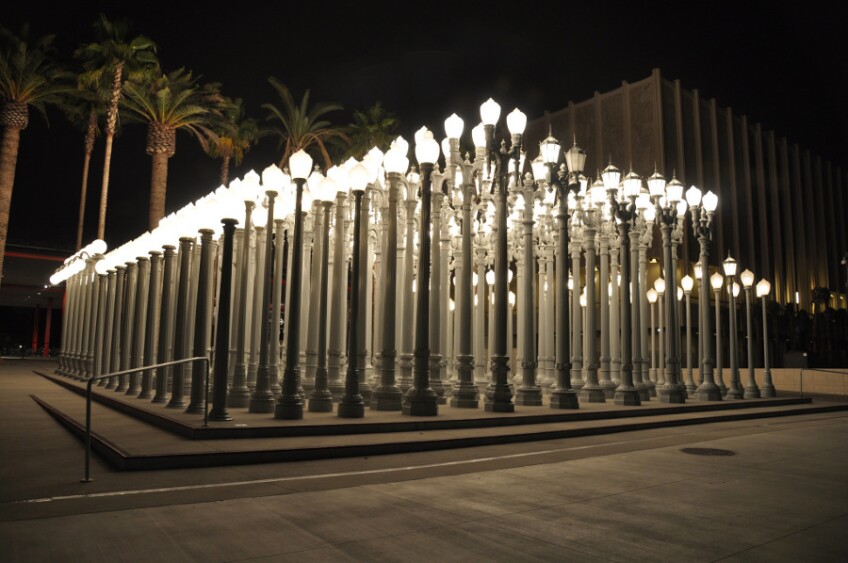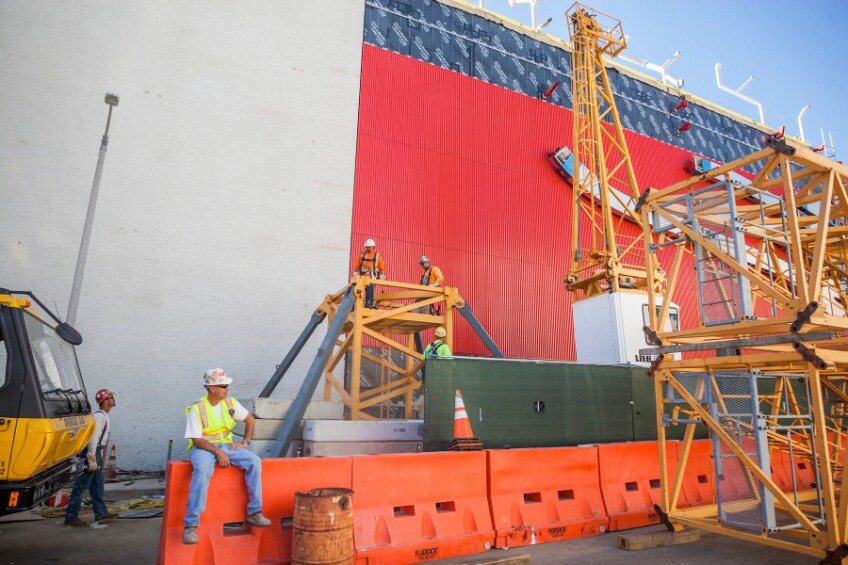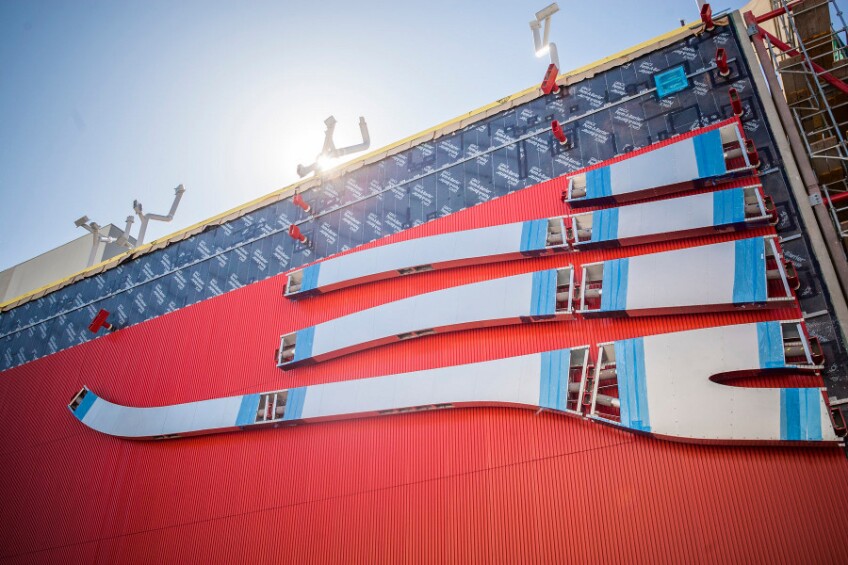The Future Look of Wilshire's Museum Row


For years now, politicians, and developers have reminded Angelenos that big changes are coming to the stretch of Wilshire Boulevard between Fairfax and Ogden. Museum Row will soon be transformed, they've promised, by public transit, contemporary architecture, high-rise development, and much more housing. Big plans like Los Angeles County Metropolitan Transportation Authority's (Metro) Purple Line extension have been in pre-planning and feasibility stages for decades, but with the unveiling last month of the Petersen Automotive Museum's flashy, animal-print overhaul to its exterior facades -- their words ring true. The transformation is underway, and its physical manifestation is emerging from east to west.
Over the next 10 to 15 years, this portion of Wilshire, approximately between Crescent Heights Boulevard at the west and Curson Avenue at the east, is expected to simultaneously expand, arise and densify. Anchoring the development boom on the west side of Fairfax is Colorado-based developer UDR's future 18-story residential tower at Crescent Heights and Wilshire. Developer Hannover Co.'s 16-story tower at La Jolla Avenue and Wilshire has been approved, and another tower, at Orange Grove Avenue and Wilshire (possibly to be designed by Gehry Partners), is likely to shoot past 30 stories. At the site of the former May Company department store building at Fairfax, the Museum of Motion Picture Arts and Sciences' renovation by architect Renzo Piano has, in the process, secured pre-planning permits and a sign district designation which will allow its owners to build up to 13,500 square feet of digital graphics and billboards on its exterior -- L.A. Live has a similar signage deal with the city. Museum Row's mothership, the Los Angeles County Museum of Art, will perhaps see its most extreme makeover since its establishment in Exposition Park in 1961, as Swiss architect Peter Zumthor's uni-level, tar blot-shaped superstructure on tubular stilts emerges from the landscape. In his plan's present incarnation, the building is likely to partially ooze across Wilshire. Fundraising is ongoing for the project. If the Zumthor building is realized, it will stand next to low-rise mixed use commercial structures and restaurants, recently-built residential and office towers, 1980's office blocks -- like the tiered green and red "Wilshire Courtyard" at Curson Avenue, as well as the Art Deco and Moderne-era department store buildings of the 1930s and 1940s like Desmond's department store at Burnside Avenue on the western flank of Museum Row.

Wilshire's patchwork formalism is nothing new, and this forthcoming next generation of styles will surely add to the boulevard's mishmash characteristic. How the new buildings might create different relationships to the street, each other, and perhaps even more significantly, how they are oriented in the blocks along Wilshire to accommodate future growth, could alter how the area operates urbanistically amid the hodgepodge of architectural eras past.
Up until now, the story of Wilshire Boulevard has been all about the automobile. In 1895, Gaylord Wilshire's four-block residential development between Hoover and MacArthur Park proposed a linear neighborhood around the car. (Orange Street in downtown and Nevada Street in Santa Monica would eventually connect in 1934 to create the 17-mile stretch we know today as Wilshire Boulevard). By 1928, developer and land baron A. W. Ross ushered in L.A.'s grand era of the department store -- those "cathedrals to commerce" -- luxurious shopping meccas like Bullocks Wilshire and the May Company, replete with tea rooms, huge street level windows and adjacencies to other high-end shops. Ross' idea to bring affluent shoppers in from Holmby Hills, Westwood and Beverly Hills (via their cars) established a design model for the street specifically catered to motorized access with portes-cocheres and expansive parking lots at the back of the property, abutting low-rise neighborhoods. The consumer pattern west along Wilshire also solidified the social geometry of L.A., linking the most desirable and expensive communities -- those not inclined over canyons or perched above beaches -- across the flat lands from downtown, to Hancock Park and Beverly Hills.

Museum Row and the Miracle Mile today neither suffer nor benefit from one relentless, figurehead developer like A.W. Ross. The buildings currently "on-the-boards" are developed and designed as per their specific clients, be they directors, investors or both. But two specific modifications to Wilshire's zoning and transportation infrastructure will dictate how these new buildings operate on the street, just as they will alter the boulevard's car-centric urban legacy permanently; L.A.'s governing powers and real-estate developers intend to transform many properties in the area for super-tall housing towers over the next 30 years, in concert with the Metro expansion towards transit-oriented design goals. (The Wilshire corridor west of downtown is one of the few areas in the city that is exempt from L.A.'s 1986 anti-high-rise legislation that affected Westwood and the Valley's development patterns.) This change will make opportunities for a more layered urban condition, one with more housing and transit options overall. Architecturally, it will make the seemingly monstrous residential development at Wilshire and La Brea, completed in 2014 and just 10 blocks away from Museum Row, seem dwarfed in comparison to future high-rises.
As is the case with the Petersen, constructing buildings that act primarily as signage will only reinforce the hierarchy of the car. (Although the design blunder is almost forgivable, it's an ironic twist for a museum dedicated to the car and its influence). Museum Row's coming configuration of contemporary architecture will need to build in a set of conditions that provide meaningful, human-scaled places for recreation, gatherings, play and, yes, potential subversion. Drawing-in pedestrians from the metro stops, and accommodating spaces for public use, occupation and interventions along those paths or within the buildings themselves will be instrumental in adjusting ourselves away from the displacement of the Ross model and the area's rapid urbanization. This already happens at Chris Burden's permanent installation "Urban Light" -- one of the most "Instagrammed" places in the city. One-off events like 2008's "Field Guide to LACMA" -- in which the local art group Machine Project arranged for 35 artists to stage 55 interventions in, around, and within the museum's un-used corners, main hallways and sidewalk areas -- re-discovered and re-programmed spaces around Museum Row for potential use and activity. The event lasted only 10 hours, but proved that pockets of social interaction and creativity could be mined from both the boulevard and the institution.


Furnishing places for activity, both programmed and spontaneous, will be as important as providing present-tense needs like extra storage, loading, traffic drop-offs -- those elements that could pose a logistical quandary if they're not vetted now. But the architecture that is re-inventing Wilshire's Museum Row doesn't look to be one that can expand or accommodate, at least not yet. London and New York-based architecture office KPF's Nike-esque "swoosh" cladding at the Petersen Museum matter-of-factly isolates all visitors within the confines of the building. And Zumthor's insular LACMA design has been derided for its "definitive geometry [which] is diametrically opposed to a future addition" by critics (this criticism came after the premiere showing of the design at the exhibit "The Presence of the Past: Peter Zumthor Reconsiders LACMA" in 2013, and the design has since become more developed). Hastily planned adjustments for expansion usually create unfortunate architecture -- LACMA's present "pavilion-ization" is proof of this.
There's no doubt about the architectural gravitas behind the forthcoming buildings along Wilshire. Piano, Zumthor, perhaps Gehry will surely deliver stunning, prominent statements in stone, steel, and glass. An applied thoughtfulness to the area's changing context in regards to economy, demographics and infrastructure needs to take an architectural form as well. Complicit in this are smaller-scale cultural hot spots peppered around the area -- L.A.'s Goethe-Institut, the Craft and Folk Art Museum, the Page Museum, as well as ACME and 1301PE galleries. Coordinated hives of activity and re-formulated placemaking with unsanctioned and planned common areas will surely transform the life of Wilshire Boulevard in more significant ways than any well-branded, swooping silver cladding.




Dig this story? Sign up for our newsletter to get unique arts & culture stories and videos from across Southern California in your inbox. Also, follow Artbound on Facebook, Twitter, and Youtube.